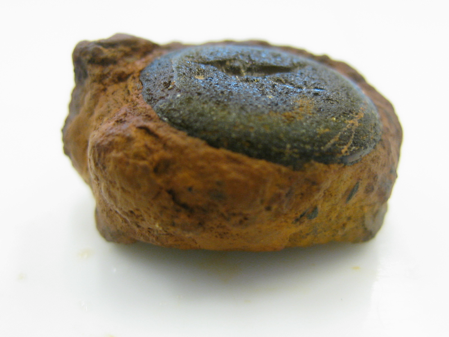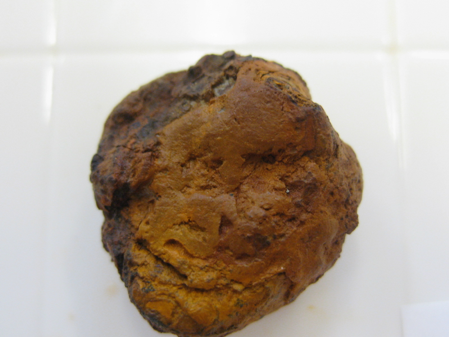Inventory Number: C-2013-451
Date of Discovery: 6/3/2013
Date of Intervention: 22/1/2015
Provenance: Cetamura del Chianti (SI) Superintendent: Archaeological Superintendence of Tuscany
Date of Discovery: 6/3/2013
Date of Intervention: 22/1/2015
Provenance: Cetamura del Chianti (SI) Superintendent: Archaeological Superintendence of Tuscany
Find Coordinates: 5N/18W. 96.2 Measurements:
Overall Object: 2.2cm(l) x 2.1cm(h) x 1.2cm(w) Gem: 1.5cm(l) x 1.1cm(h)
Weight: 6g
Overall Object: 2.2cm(l) x 2.1cm(h) x 1.2cm(w) Gem: 1.5cm(l) x 1.1cm(h)
Weight: 6g
IMAGE: Detail image of front of object
IMAGE: front of object
BACKGROUND: The item is a composite object, made of glass set in iron, found in the well at the Cetamura de Chianti site in the Tuscany region of Italy. The gem dates from the 1st century BCE, well after the generally accepted dates of the beginning of glass production within Northern Italy (8th-7th cent. BCE) and the production of wrought iron in Europe (1st millennium BCE). The object is typical of early Etruscan glass in its small size and deep blue-ish green coloring (Figs. 2 & 3). It is probable that the glass was produced using the rod form technique, prevalent in the region, and then ground into its oval shape after it had cooled. The decorative figure seen on the gem’s face would have also been carved into the surface (Fig. 1). Since it was carved in negative, enough of the figure remains today to compare it to contemporary renderings of Hercules. Using a magnifying lens, the figure can be seen depicted in profile and carrying Hercules’s characteristic club over its shoulder.
CONDITION: Overall, the object appears fairly stable. Since it was found in a damp well, it has been stored fully submerged in water in a sealed plastic container with foam blocks for added cushioning. The water was changed once on January 20th, 2014. The iron has undergone substantial amounts of corrosion, as is typical of the metal material. The surface is entirely orange with areas of dark brown and the majority is pitted and powdering when disturbed. In comparison, the glass has been well preserved, with only small chips and abrasions across the surface and minimal signs of encrustations. Examination under microscope shows possible pitting over the entire surface. Specifically, the lower section of the glass has been scratched along the left-hand side, with iron corrosion settling within. There is also thinning along the entire left side edge. It is undetermined whether this loss of the original surface layer is due to leaching or abrasion. The gem remains well set in its iron base.
IMAGE: back of object prior to treatment

detail of left side of object

detail of back of object

detail of right side of object
PROPOSED TREATMENT: The gem was found and has since continued to be stored in anaerobic conditions. For several reasons, however, it cannot remain in wet storage indefinitely. Overtime, the pH levels of the water will raise, and while buffers can be added to keep these levels in control, any unnoticed changes could induce irreversible damage to the glass. In order to truly asses the state of the object, the first step will be to allow the piece to dry while being closely monitored for the development of crystals, weeping, or flaking on the iron which would indicate a reactivation of corrosion (English Heritage 2013). If active corrosion is observed, the piece should be placed into a near desiccate environment, with an RH near 30%. From this point, the state of the glass would need to be considered before choosing an active form of iron treatment. Once dry, the glass should be observed for any changes in refraction index, fissures, changes in color, or flaking. Cracks can develop during the drying process if there is a leached layer present. Due to the difference in molecular composition between the depleted and bulk glass, their rates of contraction will also differ. If there develops a strong amount of crazing or dullness to the point of instability or obscurity of the décor, a consolidate can be considered. In this case, the scratches are so small, no gap filling should be undertaken. There is no indication that these cracks are contributing to any instability and the risk of yellowing resins or overfilling such a small area is not worth the potential harm to the incised decoration. Instead, once the state of decay has been secured, the focus should be on a protective and appropriate storage of the Hercules gem.
IMAGE: detail of cut glass inset
STORAGE AND DISPLAY: The Hercules gem is an object of interest for future research and display to the public. For this reason, a suitable environment should be considered. An environment of a steady RH between 40-50% would be safest for both materials, with air filters to eliminate any pollution (presence of acidic gases can initiate glass corrosion). If placed in an exhibition, a Climabox would be beneficial to allow for better control of these factors. Building materials can also be a source of pollution, and their emission levels should be checked prior to constructing a display case .